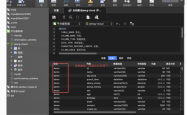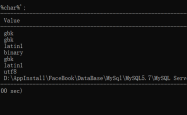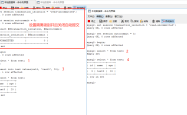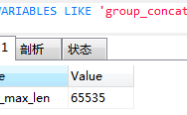MySQL 字符串拆分实例(无分隔符的字符串截取)
无分隔符的字符串截取
题目要求
数据库中字段值:

实现效果:需要将一行数据变成多行

实现的sql
?| 1 | select left ( substring ( 'p1111' ,help_topic_id+1),1) as num from mysql.help_topic where help_topic_id < length( 'p1111' ); |
涉及的知识点
一、字符串截取:substring(str,pos)
1、参数说明
| 参数名 | 解释 |
|---|---|
| str | 被截取的字符串 |
| pos | 从第几位开始截取,当 pos 为正数时,表示从字符串开始第 pos 位开始取,直到结束;当pos为负数时,表示从字符串倒数第 pos位开始取,直到结束。 |
2、 举例
(一)从第2个字符开始获取字符串'p1111'
?| 1 | substring ( 'p1111' ,2) |

(二)从倒数第2个字符开始获取字符串'p1111'
?| 1 | substring ( 'p1111' ,-2) |

二、从左边开始截取字符串:left(str,len)
1、参数说明
| 参数名 | 解释 |
|---|---|
| str | 被截取的字符串 |
| len | 正整数,表示截取字符串从最左边开始到第 len 位的值。 |
2、举例
(一) 获取字符串'p1111'最左边的3个字符
?| 1 | left ( 'p1111' ,3) |

tip:
有从左边开始截取字符串的函数 left(str,len),那当然也有从右边开始截取字符串的 right(str,len), 左右两个函数原理一样,区别在于是从左边开始还是右边开始截取字符串。
sql解析
?| 1 | select left ( substring ( 'p1111' ,help_topic_id+1),1) as num from mysql.help_topic where help_topic_id < length( 'p1111' ); |
此处同样利用 mysql 库的 help_topic 表的 help_topic_id 来作为变量,因为 help_topic_id 是自增的,当然也可以用其他表的自增字段辅助。
可参考 mysql——字符串拆分(一)
实现步骤
step1:
获取字符串 ‘p1111' 的长度,利用 help_topic_id 来动态模拟对字符串 ‘p1111' 的遍历
?| 1 | help_topic_id < length( 'p1111' ) |
step2:
利用 substring(str,pos) 函数 和 help_topic_id 对字符串 ‘p1111' 进行截取。(此处“help_topic_id+1”的原因是 help_topic_id 是从0开始的,而 substring 函数需从第1个位置开始截取字符串)
?| 1 | substring ( 'p1111' ,help_topic_id+1) |
eg:
当 help_topic_id = 0 时,获取到的字符串 = p1111
当 help_topic_id = 1 时,获取到的字符串 = 1111
…(以此类推)
step3:在实现第2步的基础上,结合 left(str,len) 函数来获取第2步中最左边的第1个字符
?| 1 | left ( substring ( 'p1111' ,help_topic_id+1),1) |
eg:
根据第2步,当 help_topic_id = 0 时,获取到的字符串 = p1111,此时第3步获取的字符串 = p
根据第2步,当 help_topic_id = 1 时,获取到的字符串 = 1111,此时第3步获取的字符串 = 1
…(以此类推)
最终成功实现以下效果

注:含分隔符的字符串拆分可参考 mysql——字符串拆分(含分隔符的字符串截取)
补充:mysql将查出的字符串拆分_mysql拆分字符串查询
我就废话不多说了,大家还是直接看代码吧~
?| 1 2 3 4 5 6 7 8 9 10 11 12 13 14 15 16 17 18 19 20 21 22 23 24 25 26 27 28 29 30 31 32 33 34 35 36 37 38 39 40 41 42 43 44 45 46 47 48 49 50 51 52 53 54 55 56 57 58 59 | delimiter $$ drop function if exists `tms1`.`getclassname` $$ create function `getclassname`(f_string varchar (15000)) returns varchar (15000) begin /* 判断字符串包含,的第一个位置*/ declare the_cnt int (15) default 1; /* 班级编号*/ declare classid varchar (20) default '' ; /* 返回的班级名称*/ declare result varchar (15000) default null ; /* 班级名称*/ declare classname varchar (50) default '' ; /* 字符串包含,的第一个位置*/ set the_cnt = locate( ',' ,f_string); /* 判断字符串包含,的第一个位置是否存在*/ while (the_cnt >= 0) do /* ,位置不存在的场合*/ if the_cnt = 0 then /* 班级编号的设置*/ set classid = f_string; else /* 字符串中获得班级编号*/ set classid = substring_index(substring_index(f_string, ',' , 1), ',' , -1); end if ; /* 根据班级编号获得班级名称*/ select ( select name from class where id = classid) into classname; /* 返回班级编号的字符串为空的场合*/ if result is null then /* 根据编号没有查询到班级名称的场合*/ if classname is null then /* 设置班级名称为空*/ set classname = ' ' ; end if; /* 班级名称追加到字符串*/ set result = classname; else /* 根据编号没有查询到班级名称的场合*/ if classname is null then /* 设置班级名称为空*/ set classname = ' ' ; end if; /* 班级名称追加到字符串*/ set result = concat(result, ',' ,classname); end if; /* ,位置不存在的场合*/ if the_cnt = 0 then /* 返回结果集*/ return result; end if; /* 截取传入的字符串*/ set f_string = right (f_string,length(f_string) - the_cnt); /* 字符串包含,的第一个位置*/ set the_cnt = locate( ',' ,f_string); /* 结束遍历*/ end while; /* 返回结果集*/ return result; end $$ delimiter ; |
以上为个人经验,希望能给大家一个参考,也希望大家多多支持服务器之家。如有错误或未考虑完全的地方,望不吝赐教。
原文链接:https://blog.csdn.net/pjymyself/article/details/81669928
1.本站遵循行业规范,任何转载的稿件都会明确标注作者和来源;2.本站的原创文章,请转载时务必注明文章作者和来源,不尊重原创的行为我们将追究责任;3.作者投稿可能会经我们编辑修改或补充。









